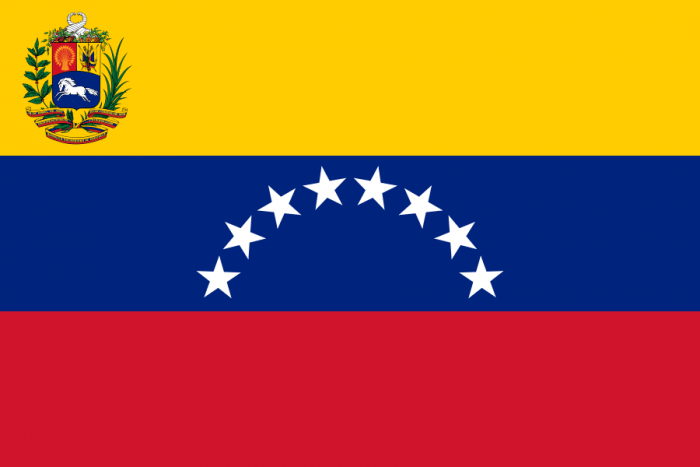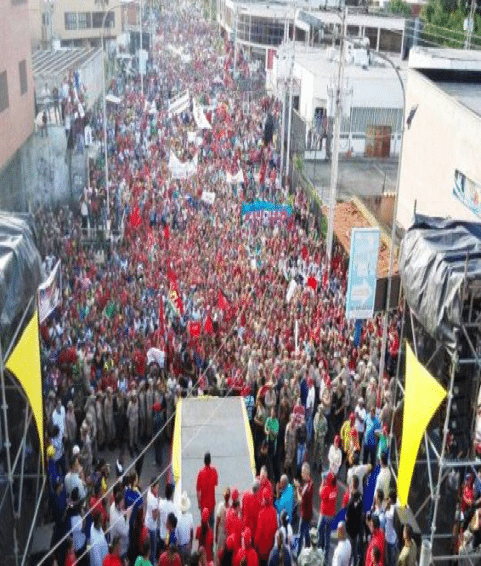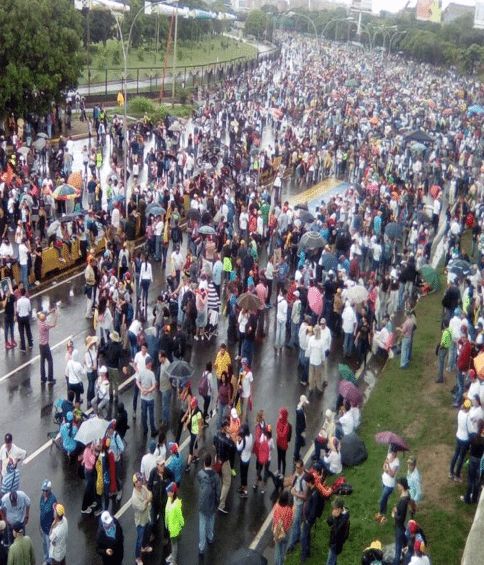“Everyone has the right to timely, truthful and impartial information, without censorship, in accordance with the principles of this Constitution” –Article 58 of the Constitution of the Bolivarian Republic of Venezuela (1999).
Claiming understanding of the current situation in Venezuela by watching mainstream media (left/right leaning), would be tantamount to claiming knowledge of the underexposed side of an iceberg by looking at its tip. For the past couple of years the Venezuelan government and its opposition have engaged in a fierce power struggle, which has spilled out onto the general public as reflected through street violence. In light of events, vast parts of the Venezuelan population are becoming increasingly apolitical. According to the two major Venezuelan pollsters, left-leaning Hinterlaces (Dec. ’16) and right-leaning Datanálisis (Mar.’17), 51% of Venezuelans consider themselves “NiNis” (ni de izquierda ni de derecha) neither left nor right, and between 33%- 45% of the population identify themselves as NiNis or Independents, respectively. The remaining portion of the population is still politically-polarized between left and right.
The following summary of events adheres to a multipolar narrative seeking to compliment the information U.S. readers obtain from conventional news outlets, in order to furnish a robust understanding of the current situation in Venezuela.
Venezuela Quits OAS
“Each morning as I open my eyes, I feel happy that I don’t have to call Washington to receive orders,” announced Delcy Rodríguez, Venezuelan Minister of Foreign Affairs, during a press conference held on Thursday, April 27 in Caracas. On the previous day, Venezuelan diplomatic staff in Washington D.C. hand-delivered a letter which President Nicolás Maduro addressed to Luis Almagro, Secretary General of the Organization of American States (OAS). The letter was the country’s official request to renounce its membership from the inter-American organization, as tensions remained high between the Venezuelan government and the OAS. Postponed regional elections, suspension of a recall referendum, an attempted parliamentary coup, failed peace talks, and acute economic crisis, have worsen the conditions fueling social discontent. The OAS has been vocal regarding political unrest and human right violations; likewise, the Venezuelan government has voiced concerns regarding the organization’s unilateral monroeism, and has denounced a soft coup d’état, à la Gene Sharp.
On May 31, the OAS consultation meeting on the situation in Venezuela was postponed “in search of consensus to solve the crisis,” as member states failed to find common ground concerning the Latin-Caribbean nation.
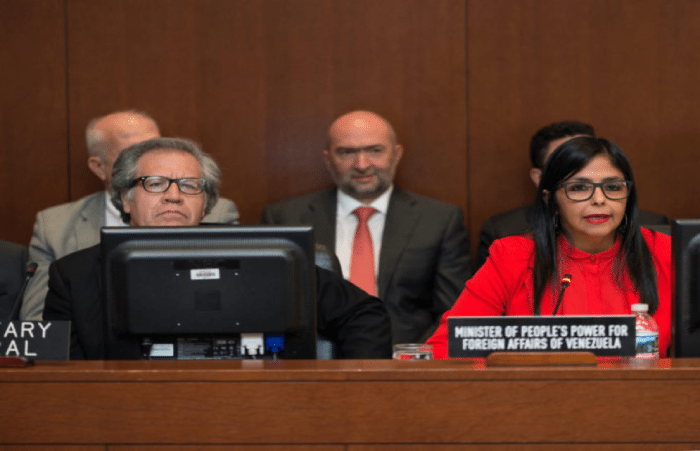

Luis Almagro (left), and Delcy Rodríguez (right) at the OAS in Washington D.C. (Photo: Juan Manuel Herrera/OAS)
Venezuela will be the first country to leave the OAS, an ordeal that takes about 24 months.
Constituent Assembly
Days after announcing Venezuela’s departure from the OAS, President Maduro signed an executive order to convene a popular Constituent Assembly, claiming it to be “the path towards peace consolidation.”
A Constituent Assembly is a mechanism by which citizens become responsible for writing the nation’s constitution through the establishment of an assembly of constituents, elected and approved by a popular referendum. The popular referendum is the first step that the nation takes as a whole, to decide if it wants a Constituent Assembly, at all.
Opposition leaders rejected the move, stating it seeks to hinder the legislative faculties of the opposition-held National Assembly, in order for the executive branch to further consolidate power.
The Venezuelan opposition announced it will boycott the popular constituent assembly convened by Maduro, and classified the proposal as unconstitutional, illegitimate and fraudulent.
Venezuela’s current constitution has been recognized by constitutionalists worldwide as one of the most progressive constitutions in the world, and is revered by Chavez loyalists as the hallmark of his legacy. Factions of the alternative left also rejected Maduro’s constituent assembly. Government officials went public to affirm that the constitution was progressive, but that it could be “perfected.”
Detractors of Maduro’s proposal are citing it as unconstitutional based on articles 347-348 of the current Constitution. Article 347, exclusively grants the Venezuelan people the original constituent power to convene a popular National Constituent Assembly, and article 348 provides the President and other political actors, the capacity to initiate the process itself, according to the statutes established therein. Interestingly enough, the Venezuelan government is also citing the same constitutional articles in defense of the proposal with backing from the Supreme Court, and opposition from the Attorney General.
On Tuesday May 9, representatives from the Citizens Platform for the Defense of the Venezuelan Constitution visited the headquarters of the National Electoral Council (CNE by its acronym in Spanish) and delivered a document requesting the annulment of Maduro’s executive order.
Some of the members of the Platform include former ministers under the Chavez administration: Ana Elisa Osorio, former minister of environmental affairs; Gustavo Márquez, former minister of commerce; former military official General Cliver Alcala; and social justice activist Santiago Arconada, to name a few. The organization called Maduro’s proposed constituent assembly an “aggression” to the Venezuelan people, suggesting that it is a political maneuver aimed at preventing Venezuelans from recovering pilfered government funds (which amount to more than $300 billion dollars) by using gerrymandering strategies via constitutional reform.
Members of the platform reiterated that peace should be achieved constitutionally, respecting the current constitution (ratified in 1999) and resuming the postponed regional elections.
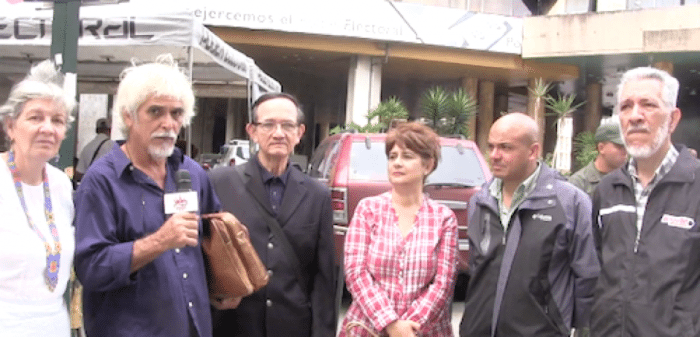

Members of the Citizens Platform for the Defense of the Venezuelan Constitution. (Photo: Aporrea TV)
On May 23, President Maduro headed to the CNE himself to provide the council with the proposed committees pertaining to the electoral bases for the constituent assembly. Afterwards, Tibisay Lucena (President of the CNE) confirmed that regional elections will be held on December 10. The opposition disregarded the announcement, based on claims that the government’s constituent assembly could change the rules of the game, leaving them out of the picture, before December 10.
Several Political Divides
The division taking hold of Venezuela’s political parties is marked by intolerance. A leftist journalist who might question the current government, runs the risk of being labeled a “CIA agent;” a right-leaning academic who might question the extreme violent discourse of the opposition, risks becoming a “sellout to the regime;” and a self-proclaimed “Chavista” who asks the government to investigate corruption, automatically becomes a “traitor.” Venezuelan politicians have become more loyal to ideology, than to the people.
Such partisan dubiousness has nourished the general public’s mistrust of the political apparatus, hence, the increase of the apolitical population. During an interview with journalist Vanessa Davies, sociologist Ignacio Ávalos, director of the Observatorio Electoral Venezolano (OEV, an accredited non-partisan organization monitoring electoral processes in Venezuela), noted that at this moment the country doesn’t have one common political vision; it has two. When Ávalos was asked if Chavistas had the solution to the crisis, he concluded that the “polls reflect that the fastest growing sector is the one dissatisfied with both political factions,” stressing that the Venezuelan people hold the power.
The Leftist Divide
In order to understand the current situation in Venezuela and the political divide, one must consider the evolutionary transition from chavismo to madurismo, originating from the power vacuum generated by the death of former President Hugo Chávez in 2013.
In the absence of Chávez’s hyper-leadership, government officials faced a leadership crisis, as Maduro’s lone leadership would not match up to the standard. The so-called civil-military union became the immediate strategy used to salvage the Bolivarian revolution. The union is established on the premise of a “collective political leadership” headed by the people along with the armed forces. The civil-military union is the current check-and-balance mechanism implemented to prevent conflicts of interest; whether that system is efficient or not, is topic for further discussion.
The civil-military union is the reason why there are many elected government officials, with military backgrounds. Members of the opposition have criticized this as “the militarization of the public powers,” further condemning the growing bureaucracy that accompanied it.
Nicmer Evans, an outspoken member of the alternative left movement, and ardent dissident chavista, has explained the power vacuum as follows, “The unadjusted transition process which transferred power from the hands of one to the hands of selected few -instead of many- contradicts the whole idea of the so-called ‘Chavismo without Chavez’ which governs [Venezuela] today; and thus arises a division within chavismo, that makes of madurismo the degenerative phase of certain factions.”
During an interview with Carlos Croes, former Venezuelan ambassador to the OAS, Roy Chaderton was asked if being chavista implied being madurista, to which he replied, no, stating that to claim one and not the other could promote a rupture within the natural evolution of political events.
Thereupon, the civil-military union, appointed bureaucrats, and the state-capitalist entrepreneurial class, filled the power void left by Chávez’s death. Together, this amalgamation of power-holders comprise a new sort of socio-bureaucratic order, which the opposition loosely calls, Boliburguesía, meaning the Bolivarian bourgeoisie. Members of the alternative left view a boliburgués, as an apolitical individual who is in power just for monetary gains, disregarding ethical principles.
And thus, the leftist divide. On one hand, officials currently in power dubbed as maduristas, and on the other, self-proclaimed chavistas who separated from Chavez’s United Socialist Party of Venezuela (PSUV). The latter consolidated with leftist factions not supporting Maduro, under the term Chavismo Crítico (critical chavismo in English), therefore forming the alternative left, out of which the most prominent group is Marea Socialista, which has become a target under the current administration.
The alternative left emitted a press-release condemning the ongoing violence and advised all Venezuelans —regardless of political affiliation— to not serve as “cannon fodder” for the interests of the various political actors, which are equally corrupt and disputing over control of oil revenues and political power for their own benefits.
The Opposition’s Divide
When discussing the division within the Venezuelan opposition, Ignacio Ávalos describes it best, “they have 45 thousand different microphones,” and they all want control. Some of the major parties comprising the Venezuelan opposition are heirs of the bipartisan system that dates back to 1958, beginning of the historic period known as Venezuela’s Fourth Republic. During aforementioned period, the country experienced a gradual deterioration of the political system characterized by violence and rampant corruption, giving way to Hugo Chávez Frias in 1998, as asserted by right-leaning scholar, Rogelio Perez Perdomo.
The Venezuelan opposition, under The Democratic Unity Roundtable (MUD), is a circumstantial conglomerate of various political parties with different agendas. Members of those political parties identify themselves anywhere from social democrats, to central left, to conservative, all the way to the ultra-right. Such plethora of political parties crammed into one organization, is the seed of discord among the Venezuelan opposition.
Feuding among the opposition is chronic. Former MUD member and politician Diego Arria, recently labeled the coalition as undemocratic claiming that only three or four parties —out of the 19 member parties— exercise absolute control.
Arria emphasized that the MUD is not a coalition aiming to save the country, but merely an electoral alliance. The politician articulated the opposition’s division as follows, “there are those who love power and have appetite for it, which is the case of political parties; and there are those of us who want to rescue liberty.” The parties that have control of the opposition coalition, are all from the far right of the spectrum.
Recently, the opposition underwent a restructuring of leadership. Now, there are nine parties overseeing the governance of the coalition, out of the nineteen member parties. This shuffling of leadership was preceded by differences which arose between opposition leaders Henrique Capriles and Chuo Torrealba. The circumstances led Mr. Torrealba to address the internal division during his radio-show, in addition to exhorting opposition leaders to reflect and stop the internal fight fueled by egos.
At the beginning of April, the Venezuelan government banned Henrique Capriles from holding office for the next 15 years for alleged misappropriation of government funds, which he denies. The opposition rejected the government’s ban on Capriles, alleging the ban is part of an ongoing coup and called Venezuelans to take to the streets in protest, demanding Capriles political rights be respected, as well as the removal of members of the Supreme Court. The government followed the opposition’s move, by asking their supporters to take the streets as well.
At the beginning of the current wave of protests, Caracas resident, Yandry Diaz (18) told a France24 news reporter how she felt about the situation, “I don’t support either side… What they want is to have us on the street, fighting and killing each other so that they can hold onto power.”
Power Clash Between Branches of Government
In Venezuela, there are five branches of power: the government controls four (Executive, Electoral, Judicial & Citizen), and the opposition controls one—the legislative branch, comprised of the National Assembly. In 2015, the opposition won the majority of the seats at the National Assembly with a popular “punishment vote” aimed at Maduro’s government.
Last year, the Supreme Court ruled against the National Assembly as being in contempt, when it failed to suspend three opposition lawmakers upon allegations of electoral fraud. This act confirmed that once the lawmakers in question were suspended from their seats, the ruling would be reversed. Consequently, any legislation passed by Parliament was declared illegitimate in accordance to the Supreme Court’s ruling. Ever since, the act of legislating has become a power clash in Venezuela. This struggle has brought about an attempted parliamentary coup, and deepened differences that tarnished the peace process.
The Crisis
Venezuelans are struggling with a severe socio-economic crisis which has depreciated average salaries. This has resulted in the dissolution of purchasing power, which has affected low-income families the most.
Since Venezuela is a rentier state depending mostly on oil revenue, the economy has been hit hard by low oil prices, resulting on a budget deficit. This deficit, in conjunction with additional factors, has contributed to a dire financial situation. One of those contributing factors worth noting, is the exorbitant black-market currency exchange rate.
The Venezuelan government has formally accused the website DollarToday of speculating on the value of the national currency (the bolivar) in relation to the dollar exchange-rate, inciting collateral damage on the financial system. Government officials argue that the floating exchange rate promoted by the website is part of the opposition’s destabilization scheme, as DollarToday is operated from the U.S. by Venezuelan expatriates. The website’s exchange rate is much higher than that of the government fixed rates. The government’s exchange system is considered problematic due to its restriction on the amount of dollars Venezuelans are able buy; a measure aiming at protecting foreign reserves. Various political actors point to the state’s fixed exchange rate system as the gateway to pilfered government funds.
The restriction on dollar-purchase has led many to buy dollars outside of government entities, fueling the black-market.
For instance, a business owner may buy a limited amount of dollars from official government entities at the hypothetical fixed rate of 400 bolivares per dollar. If the business needs additional funds, it may get them through the black market at the hypothetical exchange rate of 4000 bolivares per dollar. The black market, of course, is non-regulated and operates on a speculative supply-demand basis. Since the business’ investment was based on the black-market rate, its recoup must also be based at the same rate. Businesses, therefore, are pricing their goods accordingly, usually by means of illegal price speculation aimed at grotesque gains, which leads to inflation. When consumer prices increase and the currency devalues, money in the pockets of working Venezuelans loses value, decreasing the total amount of goods which might be purchased.
Numerous factors have contributed to the present socio-economic crisis. The black-market currency exchange rate; contraband (bachaqueo); food-shortages (induced by sabotage hoarding and lack of resources); corruption, and hyperinflation (estimated to reach 679.73% according to the National Assembly’s Finance Commission).
The government’s use of an already-limited amount of dollars to pay the foreign debt, has also contributed to the crisis. Opposition leaders argue that instead of fulfilling its commitment to pay the foreign debt, the government should use foreign reserves to import and restock scarce basic goods, which are much needed. Maduro’s government has been faithful to paying the debt in order to avoid a default, which may otherwise lead to austerity measures with adverse effects.
In an effort to deal with food shortages, the government implemented a program of food production and distribution known as Local Committies for Supply and Production (CLAP, or Comité Local Abastecimento y Producción), nevertheless, social discontent persists.
How Do Minimum-Wage Earners Survive in Venezuela?
“It seems that the business class and the government have a complot against us poor people. I don’t agree with neither one… Mr. President, what’s going on with you? Weren’t you poor before? And how about you (Lorenzo) Mendoza, hen will you stop messing with food prices, don’t you see that the people are strangled? Both of you are an irresponsible pair!” —Minimum-wage earner Ana Andrade interviewed on tv show “Habla la Calle!” (Lorenzo Mendoza is the proprietor of transnational Empresas Polar, who the government blames of economic sabotage, accusations Mendoza denies.)
Crime, a social phenomenon arising from the depths of the current situation, is part of the crisis and one of the most disturbing social issues in Venezuela today. According to official statistics, there were 21,752 homicides reported in Venezuela last year, 2016. Homicide modalities include: femicide, sicariato, and extrajudicial killings, to name a few. Fire-arms were used in 86.6% of the homicides. Victims ages 15-30, contributed 12,069 to the total figure of 21,752.
There are two perspectives, concerning the origin of the crisis. The government blames the opposition for economic warfare aiming at creating a climate of financial and social instability that promotes a “man-made humanitarian crisis,” to excuse a foreign intervention that would potentially allow the opposition to seize control.
The opposition, on its part, has officially accused the government of being responsible for the crisis itself, blaming the Maduro government of socio-economic, political, and institutional degradation arising from corruption, repression and chronic unconstitutionality.
And thus, The Crisis: The social hyperreality experienced by Venezuelans today.
Social Unrest
Venezuela has experienced social unrest periodically since 2014. The latest wave of violence erupted back in April and has extended into June 2017. The total number of victims from the ongoing protests between April and the first week of June, included 83 dead and 1276 wounded, according to the Public Ministry.
Social unrest in Venezuela follows a repeated pattern. It usually starts with violent street clashes between protesters and security forces, quickly followed by looting of businesses and serious damages to infrastructure. The next stage of violence always includes sabotaging of the oil industry, and the targeting of public institutions. Add to these, the use of mainstream media to create a continuous state of panic.
The Venezuelan government has accused the U.S. government of financing far-right factions of the opposition. The government blames these factions for inciting violence and illegally hiring Venezuelan youth to generate chaos. The opposition holds the government responsible for the current political violence, on account of state-sponsored repression, aiming at staying in power.
Peace Talks
Towards the end of 2016, the government and the opposition participated in round-table discussions aimed at drafting a plan of action to solve the crisis and achieve peace. The peace talks were mediated by a Vatican envoy, as well as representatives from the Union of South American Nations (UNASUR). All parties agreed on several key points and established a preamble for the peace agenda, but on January 2017, cancellation of the peace talks was announced; three months later violent protests resumed.
My Personal Observations
The Left: The Venezuelan left has been complaining about the same historical devils for the last 18 years: the old plutocrats, the biased mainstream media and foreign interventionism. In my opinion, let devils handle devils.
A low-income single mother surviving a 679.73% inflation rate, is inexcusable.
The Venezuelan left lost my vote.
The Right: For the past 18 years, the Venezuelan right has had the support of the global mainstream media, foreign governments, and access to wealth, yet with all of that, hasn’t overcome chavismo.
There wouldn’t be Ninis, if the Venezuelan right had strong, visionary and trustworthy leadership. Some members of the Venezuelan opposition have openly displayed violent, racist, classist and homophobic behavior, throughout the years. Disturbing to say the least.
Furthermore, the opposition’s proposal under the so-called “Government Guidelines for the National Unity, 2013-2019” is obsolete and lacks a valid solution to the current crisis. The plan of action is based primarily on an economic rescue relying upon the worn-out rentier model. Its social components reflect a watered-down version of the chavista plan. It fails to highlight a concrete roadmap with feasible benchmarks that may establish strong groundwork for the solution to the crisis.
Under their Economic Policy Perspective, encompassing guidelines #267-320 (pgs 46-49), the opposition gives a recount of Venezuelan history, then, it moves to criticize the chavista government under guidelines #321-354 (pgs 49-54). Finally, it makes its way to what seems like the plan of action, that includes only political promises, rather than an actual economic framework (guidelines #355-377). The opposition details everything that is wrong in the country, and promises to do something about it, failing to explain exactly how they will go about achieving those promises. There is not a visionary plan for a post-rentier economy.
The Venezuelan right will not get my vote during election time.
The NiNis: The NiNis are about to become the majority, if they are not already it. They are not interested in being regulated by ideology. This is the sector of the Venezuelan population ready for a post-rentier modality, not based on outdated 14th-19th century manifestos. As mentioned previously, recent polls reflect that, 51% of Venezuelans consider themselves “NiNis” (Ni de izquierda Ni de derecha) neither left nor right, and between 33%- 45% of the population identify themselves as NiNis or Independents, respectively. The remaining portion of the population is still polarized between left and right, on the political spectrum.
***
Dariana Arias is a Latin-Caribbean freelancer focusing on independent research and document translations, as well as the visual arts. She completed her academic studies at the George Washington University earning a bachelor’s degree in Political Science with an emphasis on public policy, and a minor in Philosophy. She has previous experience in policy analysis and research, and is currently chronicling unfolding events in Venezuela, her homeland.



